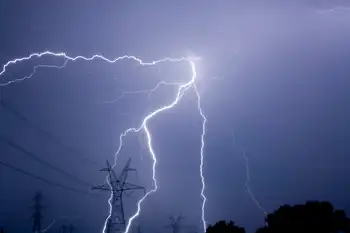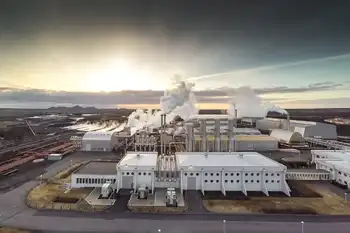LANL officials see lab's mission evolving
LOS ALAMOS, NEW MEXICO - "Complex transformation may have been the buzz-phrase of the year at Los Alamos National Laboratory, but actually, the lab has never been a stranger to mission shifts.
In the 1970s, the lab played a large role in energy initiatives for the Carter administration, in the '80s, the lab did a lot of work with the FBI, and now, while the labs historic focus on nuclear nonproliferation and managing the stockpile remains, the push is on once again for change, said Terry Wallace, the lab's principal associate director for science, technology and engineering.
"We are seeing a tremendous pressure, and rightfully so, for a shift in mission space," he said. "But that's really not a bad thing. It's easy to get overly worried about mission swings."
Talk of complex transformation across the Department of Energy and all of its labs and facilities continued throughout 2008, and could well continue to evolve this year. The National Nuclear Security Administration's plan for Los Alamos in that process is to consolidate plutonium research from other DOE facilities to the lab, to add the capability of producing 50 to 80 nuclear weapons cores called pits each year, and overall — in what might seem like a contradiction to the other missions — to reduce the stockpile and the labs' nuclear weapons-based operations.
Key to that change is a building complex called the Chemistry and Metallurgy Research Replacement facility, estimated to cost between $745 million and $975 million when completed, according to the lab's Web site.
When completed, it will house more than just nuclear weapons activities. It will also be used to train nuclear inspectors, to investigate other areas of nuclear science such as reactors or batteries for NASA spacecraft and even to look at nuclear isotopes for medicine, said Joe Martz, nuclear weapons program director.
Scientists will need the facility no matter how much the lab's nuclear weapons operations shrink. And even though the goal is to have fewer nuclear weapons and fewer people monitoring them across the entire DOE complex, the basic abilities of scientists to be able to understand nuclear weapons is something that cannot change, Wallace said.
"Something like plutonium, even though we say we can handle it safely, we still need world-class facilities and scientists to maintain those abilities," he said. "Whether you have 20 or 2,000 warheads, you still have to maintain them."
The lab will likely always have some sort of focus on nuclear weapons science, but the shift to a smaller program started before complex transformation really spread into the limelight by the middle of the year. In late 2007 and early 2008, lab management shrank the staff by about 570 employees, through attrition or voluntary reductions.
And most of those jobs came from nuclear weapons areas, Wallace said, adding he doesn't foresee any more staff reductions in the coming year.
That said, some employees who left nuclear weapons-related jobs also didn't actually leave the lab. They simply shifted to other spots that could also use their skill sets, said Mike Burns, acting associate director for Threat Reduction.
"Threat reduction, we refer to that as national security programs that do not involve our nuclear stockpile, and through 2008, our portfolio grew by 6 percent," Burns said. "I personally think there are a lot of opportunities to grow in our areas of the lab."
Threat reduction, especially in the modern era of terrorism, will probably continue to grow rapidly in coming years. In that area, the lab investigates potential threats using sensors and monitors, by creating simulations on supercomputers and by looking at ways to save energy, among other things, Burns said.
"One area that's really interesting is something called mobility energy," Burns said. "The Department of Defense is the nation's largest user of things like fuel, jet fuel, gasoline. So if the lab can help find ways to make small reductions or changes there, it can create huge benefits for the nation."
Threat reduction also works on surveillance gadgets to help improve situational awareness on battlefields, hopefully saving American lives in the process, he said.
Another big area where some activities are shifting is to energy and power issues and how to improve storage and power grids in the United States, Wallace said. "We're also looking at next generation nuclear power because it can be an important resource that doesn't produce greenhouse gasses," he said.
Supercomputer activities, as well, have grown far beyond nuclear weapons functions at the lab.
Earlier in 2008 the lab started to install Roadrunner, a supercomputer that continues to be the fastest in the world. The speeds available on that computer have opened up entirely new areas of science, Martz said.
"These changes aren't just true at the lab — the nature of science is changing," he said. "We can do things now that seemed impossible 10 years ago."
Computer models of systems like the ribosome, tiny cellular factories that transform instructions from DNA into biological material, could play a huge role in medical science in the not-so-distant future. And computer models of ocean systems and climate can help us better understand how human activities are changing those systems, Martz said.
"In some ways, through these computer systems, science is coalescing," Martz said. "Many disciplines are coming together."
Still, while activities at the lab are shifting and changing, nuclear weapons science remains a large chunk of the budget.
About $650 million of the lab's fiscal 2008 $2.074 billion budget is not tied to nuclear weapons-related activities, Wallace said.
But he thinks it's likely the budget distribution will continue to shift away from nuclear and into more of the emerging science and technology areas.
"Budgets will likely remain about the same, but the buckets that each dollar goes into may change as we transform," Wallace said.
And there's an advantage to keeping people from nuclear operations around and letting them switch to work in non-nuclear weapons-related areas of the lab, he said.
Should the nation need them to go back to nuclear work, those workers can shift back and be up to speed on the science fairly quickly, Wallace said.
Overall, It's hard to say anything definitively about exactly where the lab will grow and shrink and how funding will continue to change. The Obama administration could change many things when it takes over the White House later this month.
No matter what happens, though, the lab seems to be in good shape to handle it and continue to transform with the times, Wallace said.
"We do what the nation asks us to do," he said. "And of course we'll continue to do whatever is needed."
Related News

Electricity bills on the rise in Calgary after
CALGARY - Calgarians should expect to be charged more for their electricity bills amid significant demand on the grid and a transition to above-average rates.
ENMAX, one of the most-used electricity providers in the city, has sent an email to customers notifying them of higher prices for the rest of the winter months.
“Although fluctuations in electricity market prices are normal, we have seen a general trend of increasing rates over time,” the email to customers read.
“The price volatility we are forecasting is due to market factors beyond a single energy provider, including but not limited to expectations for a colder-than-normal winter…




